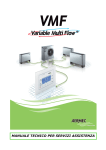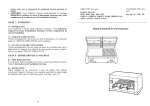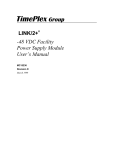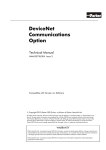Download Microtek MiniLink Operating instructions
Transcript
IMPORTANT SAFETY INSTRUCTION For your protection, please read and observe all safety instructions before operating this receiver and keep this sheet and any additional instructions for future reference. INSTALLATION OBSERVE WARNINGS: All warnings in the operating instructions should be carefully followed. WATER AND MOISTURE: Do not use or install this equipment near water. Severe electrical shock, personal injury or damage to the equipment may result. Operations Manual HEAT: Do not install the equipment near heat sources such as radiators, stoves, heat registers and other appliances that produce heat. CARE & USE POWER SOURCE: Connect the equipment to a power source only of the type described on the operating instructions or as marked on the equipment. MiniLink® 5.8 GHz System ATTACHMENTS: Use only MicroTek recommended attachments. WHEN NOT IN USE: Unplug the power if the equipment is left unattended or unused for long periods of time or during lightning storms REPLACEMENT PARTS: When replacement parts are required, use only replacement parts specified by the manufacturer or that have the same characteristics as the original part. Unauthorized substitutions may result in fire, electrical shock or other hazards and will void the warranty. FCC NOTICE This equipment has been tested and found to comply with the limits of a Class B device, pursuant to PART 15C of the FCC Rules. These limits are designed to provide reasonable protection against harmful interference. This equipment generates, uses and can radiate radio frequency energy, and, if not installed and used in accordance with the instructions, may cause harmful interference to radio communications. However, there is no guarantee that interference will not occur in a particular installation. If this equipment does cause harmful interference to radio or television reception, which can be determined by turning the equipment off and on, the user is encouraged to try to correct the interference by one or more of the following measures: • Reorient or relocate the receiving antenna. • Increase the separation between the equipment and receiver. • Connect the equipment into an outlet on a circuit different from that to which the receiver is connected. • Consult your dealer or an experienced radio/RF technician for help. Microtek Electronics, Inc. P.O. Box 3464, San Clemente, CA 92673 Information Hotline 888-36-MICRO www.microtekelectronics.com Any changes or modifications not expressly approved by the manufacturer could void the user’s authority to operate the equipment. INDEX QUICK START GUIDE SECTION PAGE # QUICK START GUIDE RECEIVER DESCRIPTION -----------------------------FRONT PANEL ----------------------------------------------REAR PANEL ------------------------------------------------REMOTE CONTROL ---------------------------------------WIRING DIAGRAM ----------------------------------------RECEIVER OPERATION --------------------------------HOW TO PROGRAM NEW CHANNELS --------------REMOTE CONTROL KEY OPERATION --------------RECEIVER SPECIFICATIONS ------------------------LNB DESCRIPTION ---------------------------------------HOW TO SETUP THE LNB -------------------------------MAINTENANCE --------------------------------------------LNB SPECIFICATIONS ----------------------------------TRANSMITTER DESCRIPTION -----------------------FCC NOTICE -------------------------------------------------FRONT VIEW ------------------------------------------------REAR VIEW --------------------------------------------------TRANSMITTER OPERATION -------------------------HOW TO SETUP THE TRANSMITTER ----------------MAINTENANCE --------------------------------------------TRANSMITTER SPECIFICATIONS ------------------TROUBLE SHOOTING ------------------------------------ 2 3-6 3 4 5 6 7–9 7 8-9 10 11 11 11 12 13 13 13 13 14 14 14 15 16 -1- TRANSMITTER SETUP 1. Remove Transmitter from box, select frequency and audio mode. (Factory set to channel 1) 2. Mount the transmitter at the desired transmit location. Position transmitter for desired polarity using rear label arrow as a reference, transmitter and receiver polarity must match one another. 3. Connect power, audio and video inputs to transmitter. LNB SETUP 1. Remove LNB from box and mount at the desired receive location in line of site with the transmitter. Position LNB for desired polarity using rear label arrow as a reference, transmitter and LNB polarity must match one another. The LNB is weatherproof. 2. Connect cable to the LNB. (Use only RG 6 coaxial cable with the supplied waterproof “F” connectors to connect Receiver and LNB. Cable length should be a minimum of 10 feet and a maximum of 200 feet.) Note: If a dish is used with the system, assemble the dish and mount the LNB in the dish as described in the dish installation instructions. Position the dish with LNB and connect the cable to the LNB as described above. RECEIVER SETUP 1. Remove Receiver from box and position it at the desired receive location. 2. Connect cable from the LNB to the “RF IN” on the back panel of the receiver. 3. Connect the audio and video outputs to a monitor. 4. Connect the power using the included 12 VDC power supply. Trouble Shooting: If video does not appear on the screen or you are having other operational difficulties, please visit the trouble shooting section on page 15 of the operations manual or contact MicroTek toll free at (888) 366-4276 for technical assistance. -2- MINILINK® 5.8 RECEIVER DESCRIIPTION C. BOTTOM VIEW A. FRONT VIEW 1 2 1 1. LED INDICATOR Indicates power is on when illuminated B. REAR VIEW 1. CHANNEL SELECT DIPSWITCH Dip switch for selection channels 1 – 10. (Receiver and transmitter channels must match) 1 2 3 4 5 1. POWER INPUT 12VDC 440 mA. Power supply included. 2. RF INPUT “F” connector, connection to LNB via RG6 coaxial cable. 3. AUDIO OUTPUT Mono audio output to video monitor or VCR, use either right or left channel 4. VIDEO OUT Supply filtered, clamped video output to video monitor or VCR. 5. VIDEO OUT Supply filtered, clamped video output to video monitor or VCR. 2. CHANNEL SELECT LABEL Shows dip switch settings for channels 1 – 10. D. WIRING DIAGRAM IMPORTANT: Use only RG 6 coaxial cable with the supplied waterproof “F” connectors to connect Receiver and LNB. Cable length should be a minimum of 10 feet and a maximum of 100 feet. Longer cable runs require line amplifier, contact MicroTek for information. 12VDC Power Supply DVR/Monitor Audio In DVR/Monitor Video In Extra Video Out -3- -4- LNB RECEIVER OPERATION RECEIVER OPERATION A. HOW TO SETUP THE RECEIVER B. MAINTENANCE 1. LOCATON The Receiver is designed to be placed on a flat surface for stability. The Receiver is not weatherproof and should be placed indoors or in an environmental enclosure if used outdoors or in a harsh environment. 2. POWER The MiniLink is powered by a 10-14.5 VDC power supply connected to the Power In connector on the rear of the case. The Receiver incorporates internal reverse voltage protection. The Receiver itself uses 220 mA of power and the LNB, which gets its power from the Receiver, uses 220 mA. Your Microtek Electronics product is an example of superior design and craftsmanship. The following suggestions will help to ensure maximum operational life. • Keep the product dry. If it does get wet, wipe it dry immediately. Liquids may contain minerals than corrode electronic circuits. • Use the system only within the environmental specifications indicated. High temperatures can shorten the life of electronic devices and melt plastic parts. • Excessive mechanical shock can damage the case, connectors or internal circuit board. 3. CHANNEL SELECT Channel selection is accomplished by programming of the 4-position dipswitch located at the rear panel. Match the dipswitches to the setting on the label for the desired channel (Any numbers visible on the switch itself are not used. The white squares indicate the switch location). 4. ORDER OF SETUP AND OPERATION • Select Frequency (Factory set to channel 10) • Connect Power, Video and Audio outputs to receiver. -5- -6- RECEIVER SPECIFICATIONS MINILINK® 5.8 LNB DESCRIPTION MINILINK® 5.8 RECEIVER A. FRONT VIEW RF SECTION Input Frequency Range Frequency Control Input Impedance IF Bandwidth Static Threshold Image Rejection 971 MHz to 1088 MHz Synthesized PLL 75 Ohms 15 MHz 6 dB (Typical) 40 dB (Typical) VIDEO SECTION Format DE-Emphasis Frequency Response (3 dB) Output Level Output Impedance NTSC/PAL CCIR 405-1 50 Hz to 3.8 MHz 1.0 V P-P +/- 5% 75 Ohms AUDIO SECTION Sub-carrier Frequency Bandwidth Frequency Response (3 dB) Output Impedance 6.0 MHz 150 KHz 50 Hz to 18 KHz 10 K Ohms (unbalanced) MECHANICAL Size Weight 4.69”w x 4.38”d x 1.44”h 16 oz POWER Power Requirements 10-14.5 VDC @ 440 mA Internally fused, reverse voltage protected (LNB power supplied by Receiver) ENVIRONMENTAL Humidity Operating Temperature 95% non-condensing -20F to +180F case temperature *For product improvement, design and specifications are subject to change without notice. -7- B. REAR VIEW 1 1. RF OUTPUT Coaxial cable output to the receiver (971 – 1088 MHz). Power supplied to the LNB from receiver through this cable at 9-16 VDC. IMPORTANT: Use only RG 6 coaxial cable with the supplied waterproof “F” connectors to connect Receiver and LNB. Cable lengths should be a minimum of 10 feet and a maximum of 100 feet. Longer cable runs require line amplifier, contact MicroTek for information. LNB OPERATION A. HOW TO SETUP THE LNB LOCATION The LNB is designed to be mounted against a flat surface for support and stability. The LNB may also be mounted with an adjustable mount for positioning. The LNB is designed for environmental applications and is suitable for use outdoors where it may encounter rain, snow, high wind, etc. B. MAINTENANCE Your MicroTek Electronics product is an example of superior design and craftsmanship. Use the system only within the environmental specifications indicated. High temperatures can shorten the life of electronic devices and melt plastic parts. Excessive mechanical shock can damage the case, connectors or internal circuit board. -8- LNB SPECIFICATIONS MINILINK® 5.8 TRANSMITTER DESCRIPTION MINILINK® 5.8 LNB The MiniLink 5.8 GHz transmitter is available in two transmit configurations utilizing directional and omni directional antennas. A directional transmit path is ideal for frequency isolation and fixed pointto-point applications. An omni directional transmit path is ideal for situations where the orientation of the transmitter is not fixed and the transmit location changes frequently. RF SECTION LO Frequency IF Output MECHANICAL Dimensions Weight Connections Cable (see note below) POWER Power Requirements 4770 MHz 971 to 1088 MHz 2.75” x 2.75” x 1.5” 7.7 oz Waterproof “F” connectors (2 included with system) RG 6 Coaxial Cable (10 ft minimum, 100 ft maximum) DIRECTIONAL TRANSMITTER A. FRONT VIEW B. REAR VIEW 6 9-16 VDC @ 220 mA (LNB power supplied by Receiver) ENVIRONMENTAL Humidity Operating Temperature RANGES 1000 Feet 2500 Feet 1 Mile 4 Mile 5 100% non-condensing -20F to +180F Transmitter to LNB Transmitter to LNB with 6” Patch Transmitter to LNB with 18” Dish Transmitter to LNB with 1 Meter Dish ALL RANGES ASSUME LINE OF SITE. RANGES CANNOT BE GUARANTEED IF THERE ARE OBSTACLES IN THE TRANSMIT/RECEIVE PATH. IMPORTANT: Use only RG 6 coaxial cable with the supplied waterproof “F” connectors to connect Receiver and LNB. Cable lengths should be a minimum of 10 feet and a maximum of 100 feet. *For product improvement, design and specifications are subject to change without notice. -9- 4 3 2 1 1. AUDIO IN Audio input from audio source, BNC coaxial connection. 2. AUDIO MODE SELECT Select audio source, line level or microphone, +5 V electret supply. 3. VIDEO IN Video input from camera source, BNC coaxial connection. 4. POWER IN Connect to power supply, connector 2.1 x 5.5 mm. 5. CHANNEL SELECT Channel selection is accomplished by programming of the 4-position dipswitch. Match the dipswitches to the setting on the label for the desired channel. Any numbers visible on the switch itself are not used. The white squares indicate the switch location. 6. LED Indicates if unit has power applied. - 10 - OMNI-DIRECTIONAL TRANSMITTER TRANSMITTER OPERATION A. FRONT VIEW A. HOW TO SETUP THE TRANSMITTER 1 2 3 4a 4b 5 1. AUDIO MODE SELECT Select audio source, line level or microphone, +5 V electret supply 2. VIDEO IN Video input from camera source, 4 inch 24 AWG white wire. 3. AUDIO IN Audio input from audio source,4 inch 24 AWG green wire. 4. POWER IN (a) Ground – 4 inch 24 AWG black wire. Also connected to 4 pin plug attached to power supply. (b) Power – Red wire connected to 4 pin plug attached to power supply 5. CHANNEL SELECT Channel selection is accomplished by programming of the 4-position dipswitch. Match the dipswitches to the setting on the label for the desired channel. Any numbers visible on the switch itself are not used. The white squares indicate the switch location. 1. LOCATON The Transmitter is designed to be mounted against a flat surface for support and stability. The Transmitter is not weatherproof and should be mounted in an environmental enclosure if used outdoors or in a harsh environment. 2. POWER The MiniLink is powered by a 6-14.5 VDC power supply connected to the Power In connector on the rear of the case of the directional transmitter or the 4 pin plug of the omni-directional transmitter. The transmitter incorporates internal reverse voltage protection. 3. CHANNEL SELECT Channel selection is accomplished by programming of the 4-position dipswitch located at the rear panel of the directional transmitter and on the front of the omni-directional transmitter. Switch and frequency settings are listed on the label below the switch access. 4. AUDIO SELECT Audio mode selection is enabled by programming the 2-position dipswitch located at the rear panel of the directional transmitter and on the front of the omni-directional transmitter. Switch settings are listed on the label adjacent to the switch access. The Audio In connector can be used for either line or microphone input levels. If an electret microphone is used, the second switch position can be selected to supply +5 V to the electret element. The +5V microphone supply should be disabled for dynamic microphone or line input uses. 5. ORDER OF SETUP AND OPERATION • Select Frequency and Audio mode. (Factory set to channel 10) • Connect Power, Video and Audio inputs to transmitter. • Position transmitter for desired polarity using rear label arrow as a reference, transmitter and receiver polarity must match one another. B. MAINTENANCE Your MicroTek Electronics product is an example of superior design and craftsmanship. Use the system only within the environmental specifications indicated. High temperatures can shorten the life of electronic devices and melt plastic parts. Excessive mechanical shock can damage the case, connectors or internal circuit board. - 11 - - 12 - TRANSMITTER SPECIFICATIONS TROUBLE SHOOTING MINILINK® 5.8 TRANSMITTER PROBLEM RF SECTION Power Output Transmitting Frequency No picture or sound, no indicator lights 50 mV/Meter @ 3 Meters 5741, 5754, 5767, 5780, 5793, 5806, 5819, 5832, 5845, 5858 MHz JRR-PS37-4 FCC ID (Directional Transmitter) FCC ID (Omni-directional Transmitter) JRR-PHL4-13 VIDEO SECTION Color Format Pre-emphasis Input Level NTSC CCIR 405-1, 525 lines 1.0 V P-P @ 75 Ohms AUDIO SECTION Input Level Line Level 0.5 V P-P @ 10 K Ohms Microphone Level 50 mV P-P Powered Input +5 V @ 25mA MECHANICAL - DIRECTIONAL Dimensions Weight Connections BNC 2.75” x 2.75” x 1.5” 9.04 oz Power supply, video BNC, Audio MECHANICAL – OMNI DIRECTIONAL Dimensions 1.5” x 2.4” x 0.43” (w/out antenna) Weight 1.8 oz Connections Power, video, audio and ground on 4 pin plug. (Video, audio and ground connections are 4 inch 24 AWG leads) POWER Power Requirements ENVIRONMENTAL Humidity Operating Temperature No Picture or sound but indicator lights are on 6-14.5 VDC @ 100 mA Reverse voltage protected Picture has sparkles or picture is grainy Video fine-tuning will not adjust channel properly. Excessive black or white sparkles on all channels Audio Sounds distorted or hearing noise, pops and clicks SOLUTION 1. NO POWER – make certain that all equipment is plugged into the proper power source. 2. Check power supply to make sure it is outputting the required voltage. 1. LNB is not pointed at the transmitter. Verify the transmitter is aimed at the LNB properly. You should have clear, wide-open line of site between the transmitter and LNB 2. Poor cable connections. Check all cable connections and connectors. 3. Defective LNB. Replace defective part. 1. Receiver antenna is not aligned with the transmitter. Readjust antenna to match polarity. 2. Video channel is improperly set. 3. Excessive signal loss between LNB and receiver. Install line amplifier. 4. LNB is defective. Check all coaxial connections. 5. Poor connections. Check all coaxial connections. 6. Water in coaxial cable connections. Check all connections, dry out if necessary and make sure all connectors used outdoors are suitable for environmental conditions. 1. LNB off frequency. Have a qualified service technician check LNB 1. Select audio is not tuned to proper sub-carrier. Check correct audio frequency. 95% non-condensing -20F to +180F RANGES SEE LNB SPECIFICATIONS ON PAGE 9 FOR SPECIFIC RANGES. *For product improvement, design and specifications are subject to change without notice. - 13 - - 14 - MICROTEK LIMITED WARRANTY Microtek Electronics extends the following LIMITED WARRANTY to the original owner/purchaser of this product: 1) If, within two years after date of initial sale, this product, or any part or portion thereof, shall prove upon examination by MICROTEK, to be defective in material or workmanship, MICROTEK will repair or replace such part or portion at MICROTEK’s option. The warranty period on the repaired or replaced part or portion of this product shall be limited to the unexpired term of the original warranty. The buyer shall be responsible for all shipping and transportation of the product to MICROTEK for any performance under this warranty. 2) Conditions and Exceptions: a) Any accident to this product, any misuse or abuse, alternation, use in modified form, or any attempt to repair this product shall void this warranty. These conditions to the warranty include, but are not limited to, incorrect power connections, physical damage due to mechanical shock, exposure to moisture, and circuit modification. b) SHOULD THIS PRODUCT PROVE DEFECTIVE FOLLOWING PURCHASE, THE BUYER, NOT THE MANUFACTURER, DISTRIBUTOR, OR RETAILER, ASSUMES THE ENTIRE COST OF ALL SERVICING OR REPAIR, EXCEPT AS OTHERWISE PROVIDED BY THE TERMS OF THIS WARRANTY. c) FOR BREACH OF ANY WRITTEN OR IMPLIED WARRANTY ON THIS PRODUCT, THE BUYER IS LIMITED TO THE FOLLOWING DAMAGES. (1) THE COST OF LABOR TO REPAIR OR REPLACE DEFECTIVE PARTS OR PORTIONS OF THIS PRODUCT, AND (2) THE COST OF THE REPAIRED OR REPLACE PARTS OR PORTIONS OF THIS PRODUCT. d) NO OTHER EXPRESSED OR IMPLIED WARRANTIES HAVE BEEN MADE OR WILL BE MADE ON BEHALF OF MICROTEK WITH RESPECT TO THE SALE, REPAIR, INSTALLATION, OPERATION, OR REPLACEMENT OR THIS PRODUCT. MICROTEK DISCLAIMS ANY IMPLIED WARRANTY OF MERCHANTABILITY OF THIS PRODUCT OR ITS FITNESS FOR ANY PURPOSE, AND THE BUYER AGREES THAT THIS PRODUCT IS SOLD “AS IS” AND THAT THE ENTIRE RISK OF QUALITY AND PERFORMANCE OF THIS PRODUCT IS WITH THE BUYER, EXCEPT AS OTHERWISE PROVIDED BY THE TERMS OF THIS WARRANTY. e) Some states/jurisdictions do not allow exclusions or limitations of incidental or consequential damages, or limitations on how long an implied warranty lasts, so the above exclusions or limitations may not apply to you. 3) Contact your dealer regarding return authorization for out of warranty repairs and any further product information. Microtek Electronics, Inc. P.O. Box 3464, San Clemente, CA 92673 Information Hotline 888-36-MICRO www.microtekelectronics.com



















